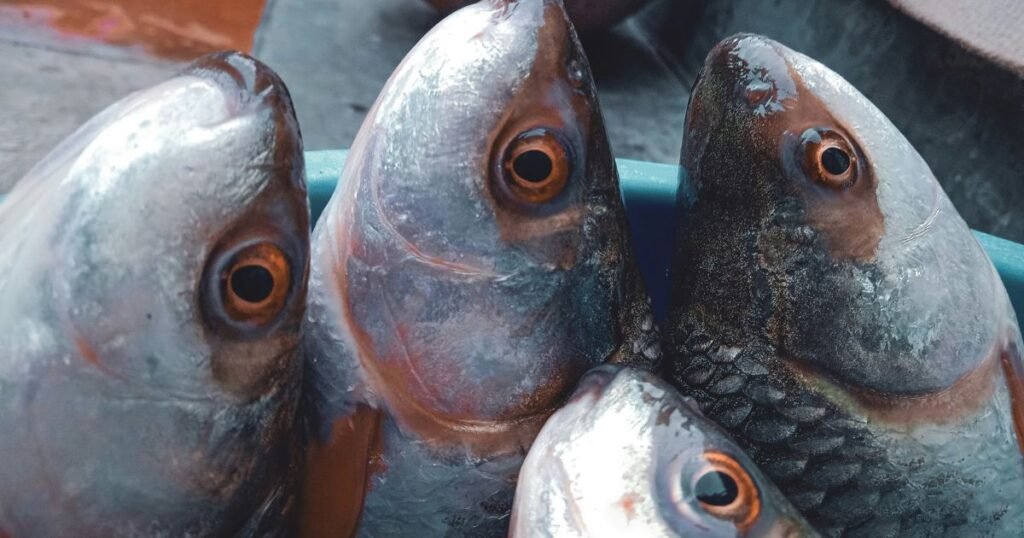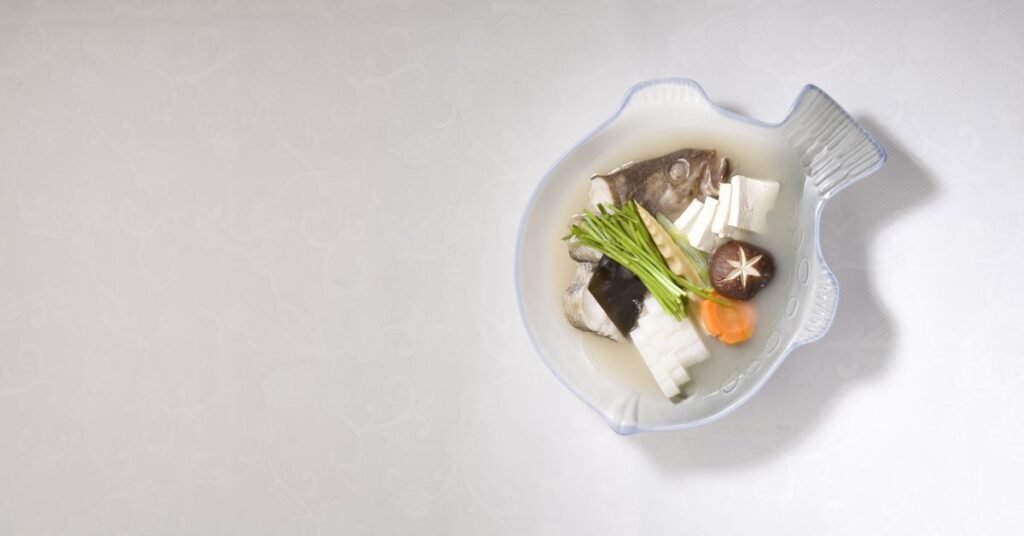Let’s talk about a soup that might surprise you in the best way. This Greek-style fish soup uses the whole fish, including the head and eyes, to create a rich, comforting broth. It’s packed with flavor, nutrients, and a little old-world charm.
Now, before you scroll past, don’t knock the eyes! In Mediterranean and Asian cultures, fish eyes are prized for their collagen and depth of flavor. They melt into the soup, making it silkier and more satisfying. It’s the kind of rustic, no-waste cooking our grandmothers would be proud of.
If you’re feeling adventurous or just want a truly authentic Greek dish, this Psarosoupa deserves a spot at your table.
- Prep Time: 15 minutes
- Cook Time: 45–50 minutes
- Total Time: 1 hour – 1 hour 5 minutes
Table of Contents
How to Make Fish Eye Soup
Ingredients
- Whole fresh fish (500g, sea bass/grey mullet) — 1 (cleaned, head ,eyes on)
- Potatoes (diced)—2 small
- Celery root (diced)—½ cup
- Carrot (diced)—1 small
- Onion (finely chopped)—1 small
- Celery leaves (fresh, chopped)—handful
- Tomato (grated)—1 large
- Extra virgin olive oil—½ cup
- Lemon (zest + juice)—1
- Salt & pepper—to taste
Prepared Method
First Step
Clean and scale your fish. Keep the head and eyes intact. Remove the innards and gills.
Second Step
In a large pot, heat olive oil and chopped onion with 5 cups of water. Bring it to a boil. Then reduce the heat and let it simmer for 15 minutes. Toss in the celery root, grated tomato, and carrot. Simmer for another 15 minutes to build flavor.
Third Step
Add diced potatoes and chopped celery leaves. Season with salt and pepper. Let it simmer for 5 more minutes. Place the fish gently on top of the veggies. Cover the pot, but leave the lid slightly open to let some steam escape. Simmer for 10–15 minutes, depending on the size of the fish. Larger fish may take closer to 20 minutes.
Fourth Step
Right before you finish cooking, stir in the lemon zest and juice. This brightens the soup and balances the richness.
Fifth Step
Traditionally, the cooked fish is removed from the pot. Gently shred the meat and return it to the broth. You can serve it as-is, or spoon it over warm bread or rice. And if you’re curious, don’t skip the eyes—they’re considered a delicacy in many homes.
You can adapt this recipe to other cuisines, such as Filipino “Sinigang na Isda” or certain Chinese fish head soups, which also feature the eyes for flavor and nutrition.
Nutrition Facts for Fish Eye Soup (Per Serving)
- Calories: 280–320 kcal
- Protein: 25–30g
- Total Fat: 18g
- Saturated Fat: 3g
- Carbohydrates: 10–12g
- Fiber: 2g
- Sugar: 3g
- Cholesterol: 70mg
- Sodium: 400–500mg (depending on added salt and fish)
- Vitamin A: 20% DV
- Vitamin C: 35% DV
- Calcium: 6–8% DV
- Iron: 8–10% DV
- Omega-3s: Moderate to High (depends on fish type)
Is It Healthy to Eat a Fish Eye?
Yes—eating fish eyes is healthy and more common than often assumed. Fish eyes are rich in omega-3 fatty acids, collagen, vitamin A, and other nutrients that support skin, joint, and eye health.
While not a typical ingredient in Western meals, fish eyes are considered a delicacy in many parts of the world, including Greece, Japan, and the Philippines. Often praised as the best part of the fish, they offer a soft, creamy texture. When simmered in soups or stews, the eyes melt into the broth, adding depth and richness.

Trying fish eyes for the first time might feel unusual. However, many who grew up with whole-fish dishes see them as a comforting, flavorful component, like the hidden secret in a well-loved family recipe.
In traditional kitchens where nothing goes to waste, the fish head, including the eyes, plays an important role. With both flavor and nutrition in one small bite, it’s a smart and time-honored addition to any full-flavored fish dish.
What Is the Tradition of Eating Fish Eyes?
The tradition of eating fish eyes goes back centuries in many cultures. It’s a way to honor the whole animal and avoid waste. In places like Greece, China, Japan, and the Philippines, fish eyes aren’t just accepted—they’re considered a prized part of the dish.
In many families, the fish eye is often saved for someone special—like a guest, an elder, or a child who loves it. Some even believe it brings good luck or sharper vision, especially when eaten fresh from a soup or stew.
The practice also speaks to old-school wisdom. Before modern cuts and filets, cooks used every part of the fish to create deep, rich flavors. Fish eyes added body to broths and a smooth, almost buttery texture when cooked down.
Today, eating fish eyes may sound unusual in Western kitchens, but in many homes around the world, it’s a normal (and beloved) tradition. It’s a reminder that sometimes the best flavor hides in the smallest, most overlooked places.
Greek Fish Eye Soup
This traditional fish-eye soup isn’t locked into one regional identity. In the Philippines, Sinigang na Isda takes on a sour edge from tamarind or calamansi, often with tilapia or bangus heads left intact. In Chinese coastal regions like Taiwan, Fujian and Guangdong, fish head soups are simmered slowly with ginger and tofu, sometimes using the collagen-rich eyes of grass carp or bighead carp to deepen the broth. Some Caribbean islands, particularly Trinidad and Jamaica, include fish heads and eyes in spicy pepper pot soups, often tied to colonial-era cooking that forced enslaved families to use discarded cuts.
Beyond flavor, the eyes bring something else to the pot: nutrients. Fish eyes contain omega-3 fatty acids, vitamin A, and gelatin, making them a quiet superfood in cultures that can’t afford to waste a scrap of protein. In refugee camps and remote fishing villages from Myanmar to Sierra Leone, fish eyes are sometimes the most nutrient-dense part of the meal.
Even in Greece, not everyone embraces the idea. In upscale restaurants in Thessaloniki or on Santorini’s tourist circuit, fish heads rarely make it past the kitchen. But among older generations—particularly in households from Crete to Kavala—psarosoupa made with the whole fish is both memory and survival. It’s how families stretched a single catch across five mouths. You don’t discard the eyes if you’ve known real hunger.
This version remains adaptable. You can swap sea bass for grouper, sardines, or even freshwater species like perch, depending on what’s available. Just make sure the eyes are intact. They’re the reason the broth turns from bland to bold.
Final Thoughts
This Greek fish eye soup isn’t just a recipe, t’s a reminder of how simple ingredients, when used fully, can create deep, nourishing flavor. The whole fish, from head to tail, brings both taste and tradition to the table.
For generations, families around the world have embraced every part of the fish—not just for nutrition, but for respect. The eyes may seem unusual at first, but they melt into the broth and give it soul.
It’s humble, hearty, and full of old-world comfort. Whether served on a quiet night or passed around a crowded table, this soup speaks to something timeless: real food, made with care, shared with pride.



